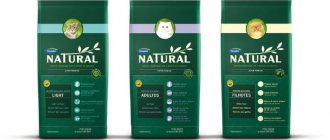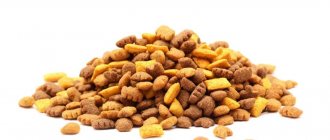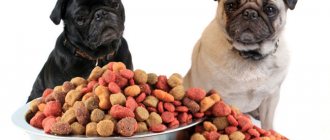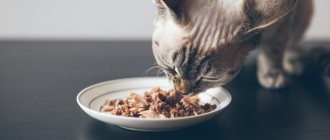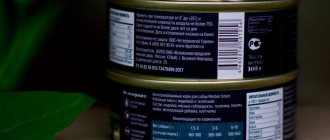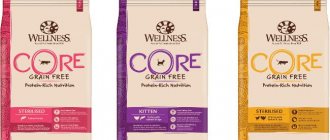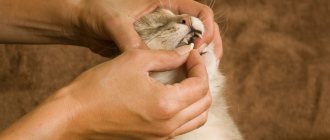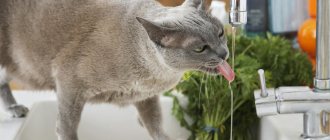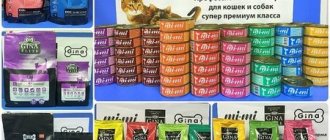November 27, 2020 views
This simple visual overview table of the qualitative composition of the feed at one time helped me “sort out on the shelves” information regarding all these “raw” feed components. I hope that it will be useful for my readers too.
Any food consists of water and dry matter. The dry matter contains an inorganic component (raw ash) and an organic component. The organic matter of feed is crude protein, crude fat and carbohydrates. The energy of the feed is mainly contained in fat and carbohydrates. Carbohydrates are non-structural (starch, sugar, etc.) and structural (hemicellulose, cellulose, lignin). Structural carbohydrates are part of crude fiber.
Essential Nutrients:
How dry industrial mixtures are produced
Before a brand is approved for release, feline nutritionists work. They develop and approve the composition of the final product.
According to the finished recipe, all components are mixed in special units: meat, offal, vegetable raw materials, additional ingredients - preservatives, stabilizers, additives. The finished mass is pressed through a sieve, the cells of which have the shape of future granules.
After drying, the finished pieces are treated with a special composition - a mixture of fat and ingredients that give the food a taste that is attractive to the cat.
Meat after drying cannot occupy more than half the volume, its usual rate is lower - about 35 percent, therefore, if it is not in first place in the list on the product label, this is normal.
The advantage of any food is the absence of flavors and dyes, components that are clearly harmful to animals.
The daily intake of the mixture is also important - the lower it is, the more nutritious the food.
The moisture content of dry food is always no more than six percent.
Main properties and characteristics
Homogeneous granulated feed is better absorbed than conventional feed mixtures. Its use has a positive effect on the profitability of agricultural production and provides a high economic effect. As for the composition, the recipe is developed separately for all groups and types of production animals.
The properties of feed are influenced by the following indicators:
- humidity and hygroscopicity;
- granulometric composition (fraction size can range from 0.5 mm to 4 cm in diameter);
- flowability (the value of the angle of repose and the coefficient of internal friction are taken into account);
- fragility and water resistance of granules;
- density, viscosity and self-sorting;
- volumetric mass.
The physical and chemical characteristics of animal feed depend on the properties of the components that make up it and the ratio of the components. The flowability of the feed is affected by the size of the granules and the value of the equilibrium moisture content. The chemical properties are influenced by the percentage of fiber, fat, protein and other substances.
The standard for mixed feed specifies its purpose and quality requirements. Each batch of products leaves the warehouse with a certificate. The consumer receives a document indicating the company that manufactured the product, the recipe number, the purpose of the feed, the composition of the mixture and the date of manufacture.
Wet food
They can be considered an intermediate link between canned food and dry mixes.
The main difference is humidity and packaging. These are usually single-dose food packets that are soft morsels in a jelly or sauce. Their humidity is much higher than that of dry food, but lower than that of canned food and is no more than 35 percent.
If the cat does not finish the portion, it quickly dries out and becomes unusable. You can put half a sachet in a bowl, open it and store it in the refrigerator.
Description of brands: advantages and disadvantages, reviews
Let's take a closer look at the formulas of the best grain-free cat food, their quality characteristics, and highlight the pros and cons of the brands.
Orijen
The best grain-free food from the Canadian company Champion Petfoods. Production facilities are located in Canada and the USA. The entire line produced belongs to the highest class - holistic. The formula of the food is as close as possible to the natural diet of a cat as a predator. The formula contains fresh and dehydrated meat and fish products.
All foods contain by-products, cartilage, vegetables, legumes and fruits with a low glycemic index, berries, medicinal herbs and other healthy additives. Raw materials are carefully selected and tested; only products that can be consumed by humans are used in production. The share of animal raw materials is 85-90%.
Pros:
- complete, suitable for daily feeding of cats of all breeds and ages;
- local fresh and raw materials are used;
- the share of plant raw materials is less than 15%;
- There is a formula for overweight kittens and cats.
Minuses:
- there are no brands for pregnant, spayed or neutered animals;
- high price;
- not always freely available.
Price: pack 1.8 kg. – 1900 rub./1150 UAH.
Reviews
Elena, owner of a Persian cat: “My Thomson is already 7 years old. He is a castrato. We experimented with food for a long time, choosing the right one. As a result, he developed a food allergy to chicken meat. The doctor recommended that we switch to Orijen Regional Red.
I was surprised by the composition. The formula contains several types of meat: beef, lamb, wild boar, bison, pork. In addition to meat, offal and fish of three types are included. Plus vegetables, herbs, seaweed and berries. The result appeared within a month - the cat’s dandruff disappeared and he began to itch less. After 1.5 months, the appearance of the fur changed, it began to shine.”
Andrey Zakharovich, veterinarian: “After the sterilization operation, I advise my clients to switch to Orijen Cat Fit & Trim Grain Free food, which helps control the pet’s weight. By the way, we recommend this same brand for obese cats. It has more protein and less fat.
The food consists of almost only meat and fish. The only thing I always warn about is that this diet may not be suitable for allergic cats and animals with food intolerance. There are too many different sources of protein in it.”
Read more about Orijen food.
Video review:
Acana
Another high-quality grain-free holistic product produced by Champion Petfoods (Canada). The composition of the food fully satisfies the physiological needs of the cat.
The food is produced according to the “whole extraction” principle: the composition includes meat, entrails, cartilage, and bone marrow. Plant components are represented by “slow carbohydrates”.
Pros:
- all feeds are complete;
- containing 75% meat and fish raw materials;
- quickly saturate the cat and maintain a sufficient level of energy;
- do not contain potatoes, GMO products, artificial additives.
Minuses:
- limited range of flavors;
- there are no medicinal or specialized feeds;
- high price.
Price: pack 1.8 kg. – 1800 rub./1100 UAH.
Reviews
Sofia, Maine Coon owner: “When Timosha came into our family, everyone loved him. He's so cute! We decided to buy the best food for our pet so that he could live long and make us happy. We were choosing between two brands from the same manufacturer and decided to take Acana. This is a very good diet.
Everything in the composition is only fresh and natural. A lot of meat. There are no components that cause cats to gain excess weight. The cat likes it and eats with pleasure.”
Roman Aleksandrovich, veterinarian: “The only brand of food about which I can’t say anything bad. The only downside is the price. But how can quality be cheap?
All the animals to whom I have recommended this food are in good health, excellent physical shape and activity.”
Read more about Acana food.
AATU
Dry holistic product from the UK, based on free-range poultry meat. The range of flavors is represented by several dry and wet rations.
Among them there are formulas with one type of protein (duck and chicken), which is important for cats with allergies. Poultry and fish (fresh and dry) make up 85% of the formula. The remaining 15% is represented by legumes, fruits, vegetables, berries, healthy herbs and spices. Salmon is used as a source of fat.
Pros:
- eat dry and wet food;
- monoprotein formula;
- balanced protein (34%) and fat (18%) content;
- High-quality fresh meat is used in production.
Minuses:
- There is no formula for kittens and pregnant cats that have been spayed or neutered;
- high price.
Price: packaging 3 kg. – 2500 rub./1050 UAH.
Reviews
Alexey, owner of the Abyssinian: “In the advertisement for the eternal Energizer battery, it was necessary to film not a hare, but my cat. He doesn't sit still! This is a real bundle of energy. To restore these strengths, he needs high-calorie and highly digestible food. He and I found our brand - this is the AATU grain-free diet.
Yes, he's expensive. But the consumption is very economical. And what does my smart handsome boy look like! All my friends are delighted with the cat."
Zinaida Nikolaevna, veterinarian: “What attracts me most is that the manufacturer produces monoprotein formulas. For cats with allergies, this is a real salvation. I always recommend a single protein diet for these patients."
Read more about AATU food.
Wildcat
The name of the German holistic food is translated as “wild cat”. The manufacturer has tried to create a formula that satisfies the natural needs of the cat.
The product line is represented by several types of dry food and canned food. The share of meat ingredients in all types of food of this brand is 70-80%. Jerusalem artichoke is used as carbohydrates.
Pros:
- does not contain grain, soy, potatoes or legumes;
- there is food with exotic types of protein: horse meat, pheasant, deer meat;
- enriched with berry-herbal mixture and prebiotics.
Minuses:
- there are no medicinal or specialized feeds;
- not always available for free sale;
- high price.
Price: packaging 3 kg. – 2200 rub./910 UAH.
Reviews
Taras, owner of a Bengal cat: “Bengals need a lot of meat. Meat is all these nimble, athletic and sociable cats need. I can’t feed him natural food; I have neither the energy nor the time to cook.
I feed dry food and holistic food. Wildcat food contains up to 80% meat and meat products. As much as my active cat needs. This type of nutrition suits him perfectly. The cat looks luxurious and spends his days storming closets, climbing his tree, and running around the house.”
Denis Rodionovich, veterinarian: “Wildcat is a very high-quality food made in Germany. It is confidently one of the top five best cat foods. Decent composition, excellent tolerability by cats. There have been no cases of allergic reactions in my practice.”
Optimal
Grain-free dry diet super-premium food Optimeal is produced using Swiss technology. All raw materials used in production undergo strict selection and laboratory testing. The finished products have received high marks from the Dutch Institute of Animal Nutrition (KENNEL DE MORGENSTOND), the Warsaw Institute of Veterinary Medicine and the Institute of Animal Nutrition in France.
The line of flavors is presented in two formulas: with duck and vegetables, with turkey and vegetables. Dehydrated poultry meat is used as the protein component.
The main source of carbohydrates is potatoes. The formula is enriched with a proprietary immune complex - Immunity Support Mix, which consists of prebiotics, natural antioxidants and beta-glucans - components that have a direct effect on the cat's immune system.
Pros:
- does not contain gluten (cereal gluten), suitable for feeding cats with gluten allergies;
- the absence of grain crops in the composition and the presence of berries and vegetables helps improve the functioning of the nervous system and gastrointestinal tract;
- high content of vegetables – a source of “slow carbohydrates”, prevents the development of diabetes;
- low price;
- exported to 16 countries;
- strengthens the cat's immunity.
Minuses:
- limited range of flavors;
- no grain-free formula for kittens, pregnant or neutered animals;
- It is not always available for free sale outside Ukraine, but is exported to 16 countries around the world.
Price: packaging 4 kg. – 650 UAH.
Read more about Optimeal food.
Reviews
Anton Dmitrievich, veterinarian: “This is the first domestic food that I confidently recommend to my visitors. Yes, it is slightly inferior to elite foreign brands from Canada and the USA, but its cost and availability justifies everything.
Pets who eat Optimeal are often brought to me, and I can observe how they change. All cats who receive this food look great, they are in good physical shape, without obesity or malnutrition.”
Lesya, Persian’s owner: “My Persian is so picky - terribly picky about food! And I started eating the new grain-free food right away. As if he guessed that it was healthy and locally produced.
I was attracted by the inscription on the packaging that the food increases immunity. And, indeed, the cat is healthy and looks luxurious. The manufacturer did not disappoint my expectations.”
Video review:
Applaws
A quality British grain-free cat diet contains 80% meat ingredients. Available in the form of dry food and wet canned food.
The manufacturer offers several types of flavors and specialized brands of food: for kittens, for older cats, hypoallergenic food. Potatoes are used as a source of carbohydrates. Enriched with vitamins, minerals and prebiotics.
Pros:
- high percentage of animal protein;
- natural preservatives (rosemary, mixed tocopherol);
- no corn, soy or gluten;
- wide range.
Minuses:
- difficult to buy in Ukraine;
Price: pack 2 kg. – 1150 rub./480 UAH.
Reviews
Anton, owner of the Sphynx: “My cat is already an old man. I was looking for a brand of diet for senior pets and found British grain-free food Applaws Senior Cat Chicken. The formula is based on chicken and vegetables. Chicken makes up 80%. I think this is an excellent indicator!
It does not contain grains; sweet potatoes are used as carbohydrates, but there is very little of it (6%). For that kind of money, the composition is excellent!”
Valentina Romanovna, veterinarian: “In Ukraine, this brand is not very common because of the difficulty of purchasing it. However, some of my clients say that they order food through online stores.
I cannot speak about the brand objectively because I have no personal experience of using it. But the composition of the diet and the detailed description of the ingredients on the packaging inspire confidence in me.”
Learn more about Applaws food.
Grandorf
This is a Russian brand, but production facilities are located in Belgium and Italy, so the food is of true European quality. The manufacturer indicates that meat ingredients make up 70% of the formula.
The brand is positioned as hypoallergenic. Grain-free diets for cats include: dry food “White fish with sweet potato” and canned food in several flavors: “Tuna fillet with crab meat”, “Chicken breast with shrimp”, “Chicken breast with salmon”, “Chicken breast with duck fillet”, “ Tuna fillet”, “Tuna fillet with shrimp”.
Pros:
- high-quality varieties of dietary meat and fish are used in production;
- maintains physiological acidity of urine;
- does not contain flavorings, dyes or preservatives.
Minuses:
- the manufacturer does not indicate the percentage of components;
- There are no fresh or raw ingredients in the composition; the meat is used in dried form.
Price: pack 2 kg. – 1400 rub./850 UAH.
Reviews
Valeria, owner of a Maine Coon: “When we first took Marcel into the house, the veterinarian advised us to introduce him to healthy holistic-grade food. We chose the Grandorf brand with white fish. Why this one? Firstly, the food is made from high-quality raw materials that can be eaten by humans. Of course, we didn’t try the granules ourselves.
Secondly, it does not contain grain, soy and gluten - which means it is healthy and there is an unlikely risk of allergies to food components. Now about the result - the kitten is growing by leaps and bounds. Well-fed, cheerful, satisfied. Wool is the envy of everyone. The tail is a sight for sore eyes. This brand is probably right for us.”
Anastasia Viktorovna, veterinarian: “Grandorf food is produced in Europe. This is an indicator of quality. I recommend this company's grain-free brand to my clients along with market leaders in holistic foods: ACANA and ORIJEN. Grandorf is cheaper, but does not differ very much from more expensive brands in composition and quality characteristics.”
Carnilove
The Czech-made grain-free diet comes in several flavors; there is special food for kittens, sterilized and neutered animals, and large breed cats.
Various types of meat (boar, lamb, deer), poultry (duck, pheasant, turkey) and fish (salmon) are used as protein components. Protein products make up up to 60% of the formula. Source of plant carbohydrates - peas, beans.
Pros:
- no artificial additives;
- contains natural sources of glucosamine and chondroitin (crustacean shells, cartilage extract);
- contains prebiotics;
- There is a detailed breakdown of the composition on the packaging.
Minuses:
- does not contain fresh or raw meat, dried flour is used;
Price: pack 2 kg. – 1440 rub./510 UAH.
Reviews
Regina, owner of a Siamese kitten: “When I decided to switch the kitten to holistic food, I came across a pack of interesting design. Maine Coon kittens or small lynx cubs were drawn on it. It was Carnilove brand food with salmon and turkey.
I liked the granules - they do not have a strong smell and are the optimal size for a kitten. The kitten did not immediately begin to eat. They say that this happens when you switch to “holistic” pets who are already accustomed to cheap brands with flavors and taste enhancers.”
Anton Vyacheslavovich: “When cat owners contact me who are worried about the pet swallowing its own fur, I recommend special food and malt pastes. Carnilove Cat Duck & Pheasant Hairball Control is one such food.
If you constantly feed your pet this food, the animal’s stomach and intestines will spontaneously cleanse themselves. This composition is especially suitable for long-haired breeds during the shedding season.”
Baskerville
The line of super-premium food produced in Germany is represented by dry brands and a wide range of canned foods. The dry grain-free menu includes chicken-based food for adult cats. The protein content in the dry formula is 36%. Carbohydrates are represented by sweet potatoes.
Various types of meat, fish, poultry, and offal are used in the production of canned food. The meat component in canned food is 70%. The entire line is enriched with vitamins and minerals.
Pros:
- does not contain dyes or preservatives;
- full-featured.
Minus
- sold through online stores;
- widespread only in Ukraine.
Price: packaging 1.5 kg. – 322 UAH.
Reviews
Rodion: “I have a cat from a shelter, a noble noble breed. When I first got her, she ate everything. Then I got used to the fact that there was always food and became picky. He loves canned food from jars as a treat. Pauchi doesn't really like it. I offered her different brands until I settled on Baskerville products.
My cat and I love that the company makes so many different flavors. You can always try something new. There is a lot of meat in canned food. There's just meat, broth and jelly. No grains or other additives. For this I give the brand a solid A.”
Nina Sergeevna, veterinarian: “The line of grain-free food from this company from Germany is represented by only one diet. All other foods contain grains. Therefore, I always tell my clients to carefully read both the name of the food and its detailed composition.
Of course, grain-free formula is better for cats. I always recommend grain-free menus. Cats don't need grain! Producers put grain in to save money.”
Nutram
The Canadian company's grain-free line for cats is represented by the Nutram Total Grain Free brand, which is available in two flavors: “Salmon and Trout”, “Turkey, Chicken and Duck”. The food belongs to the “holistic” class. The manufacturer positions its product as suitable for feeding cats of all breeds and ages.
The protein component accounts for 36% of the composition. There are no soy, grains or GMOs listed in the ingredients list. Legumes are used as a source of carbohydrates.
Pros:
- fresh meat is used in production;
- the food is enriched with vitamins and minerals.
Minuses:
- poor assortment;
- small granule size;
- the volume fraction of legumes in the formula exceeds 40%;
- It is not specified what flavoring is used.
Price: package 1.8 kg. – 1500 rub./660 UAH.
Reviews
Olesya, owner of a British cat: “I accidentally saw this food in our store. I was attracted by its price. Canadian production and grain-free composition inspired confidence. My cat didn’t eat right away. For some reason she didn’t like him, she had to accustom him gradually.
Over time, she got used to it and now we only eat Nutram Total Grain Free. The disadvantages of the brand include very thin packaging and the absence of an internal reflective coating. I think that the food may deteriorate from the penetrating light, so I pour it into an airtight iron jar.”
Vasily Nikolaevich, veterinarian: “When they ask me for advice about this brand of food, I don’t dissuade clients. The food is good. Of course, it would be a stretch to call it a full-fledged holistic remedy, but there are no harmful ingredients in it.
Most animals tolerate it well. No one has contacted me personally with an allergy to this brand. There is an opportunity to buy more expensive food - buy it. No – this is also a good option for feeding.”
Canned food - production and difference from dry food
Wet food is produced similarly to dry food, but instead of drying, the technology includes preservation of the semi-finished product.
The moisture content of canned cat foods - purees, stews, jelly, mousses and others - reaches eighty percent. It is important to know it in order to correctly determine the composition of other components, most importantly - proteins and fats.
For example, at 80% humidity, the can says 5% fiber content. By calculating this share from the remaining 20% of dry products, you can see that in fact its content is 25%. The same recalculation can determine the content of fats, proteins, and macroelements.
It’s a bad sign if the canned food label contains the words “flavors of.” This only means that the composition contains artificial flavors.
In developed countries, it is prohibited to write “all” on the label, which means that the product consists of 100% one component - meat, fish, etc. This is technologically impossible and is a trick of the manufacturer, a deception.
Preservatives and binders
Rosemary A cancer preventative, it is also an excellent preservative, which is why it is added to dry food.
Citric acid Natural preservative. It is found in large quantities in lemons, from which it was first obtained. Currently, it is obtained from shag stems, currants, lingonberries, rowan berries and much more.
Phosphoric acid Antioxidant, acidity regulator
Starch
Chemical preservatives BHA/BHT (aka BHA/BHT) In some countries, they are banned for use in canned food for humans, but they continue to be used for animals!
BHA (Additive E320, Butylhydroxyanisole) The International Agency for Research on Cancer says that BHA is a human carcinogen. BHA also chemically interacts with nitrates, as a result of which the compounds acquire mutagenic properties, that is, they cause changes in the DNA of cells. In many countries, BHA is listed as a red food additive, meaning it has the highest level of danger.
BHT (additive E321, Butylhydroxytoluene) is of synthetic origin and has a high level of danger (if systematically used, it is significantly harmful to health). It is thought to cause hyperactivity in some children and may also increase the risk of cancer.
Propyl gallate has an effect on the body similar to the effect of the female sex hormones estrogen. The food additive E310 causes asthma, stomach irritation and allergic skin rashes, as a result of which the use of this additive is prohibited in the production of baby food, especially for young children, and it can easily be present in kitten food! Some scientists have suggested that propyl gallates may cause the growth of malignant tumors, but this issue has not been fully studied.
Raw natural food
A fairly young generation of super premium food. These are natural meat products, usually blast frozen. Every year they become more and more popular among supporters of healthy animal nutrition, since this diet is most similar to the natural one. In our country you can buy such food from American brands Balanced Blends, Darwin's Natural Pet Products, Primal. A well-known domestic brand is Superpet.
Natural food contains fresh raw meat (chicken, turkey, quail, beef, lamb, rabbit), vegetables, eggs (quail and chicken), bran, vitamins and microelements.
The advantages of such nutrition are the absence of vegetable protein, preservatives, flavors and flavor enhancers.
Features and advantages of combined feeds
The use of complete feed in the form of granules, grits or briquettes significantly increases the productivity of dairy cows, young cattle, pigs, poultry, rabbits and other animal species. They reduce the cost of organizing feeding and preparing nutritious feed mixtures. Their effectiveness has been confirmed experimentally. However, it appears only when the production of mixed feed is carried out taking into account all the requirements prescribed in GOSTs.
The main advantages of using mixed feed over feeding certain types of grain fodder:
- milk yield of dairy cows increases by 10–20%;
- the consumption of nutrients for the formation of milk in dairy herds is reduced by 7–15%;
- the productivity of all types of farm animals increases by 10–12%;
- when the feed is enriched with microelements, vitamins and bioadditives, productivity increases by 20–30%;
- fattening pigs increase weight gain by an average of 30%;
- animals get sick less, the risk of livestock mortality is reduced.
Industrial feed composition tables
The tables list all possible components and evaluate them; those that may be harmful to the cat’s health are separately noted.
Meat ingredients
| Ingredient | Allowed and prohibited components | |
| Meat* | Beef pulp, fat, cartilage, heart, tongue, etc. | |
| Meat by-products | Entrails, bones and blood. There should be no horns, teeth, hooves, fur. | |
| Bird | Carcasses with bones and skin. | |
| Poultry by-products | Bird entrails, bones and blood. No - feathers. | |
| Flour | meat | Dried and ground meat and offal. Cannot contain bones, blood, fur, feathers, hooves, horns, etc. |
| meat and bone | Dried and ground meat, bones and offal. Phosphorus content – not less than 4%, calcium – 8.8%. The protein content (digested with pepsin) is no more than 12%. | |
| from offal | Dried and ground meat and offal into flour. | |
| Hydrolyzed protein | Protein broken down into amino acids. According to manufacturers, it does not cause allergies in cats. The nutritional value and safety for the animal are questionable. | |
| Bacon | Natural flavor. | |
| Bouillon | A decoction of meat and bones (the label should indicate what it is from - pork, fish, etc.). Typically includes monosodium glutamate. A good alternative to water to increase feed moisture. | |
| Fat | beef | Natural attractant, source of Omega-6 acids. |
| chicken | ||
| Chicken oil – rendered internal fat | ||
| Skim milk | Typically used only in kitten foods. Contains protein and lactose, which are not digestible by adult cats. | |
| Porcine plasma | Low quality protein from: | blood. |
| Egg powder | crushed and dried eggs. | |
*Meat - beef, pork, goats, sheep - do not require the type of animal to be indicated on the label. Poultry, venison, buffalo and others - species must be specified.
Cereal ingredients
| Fillers forming feed granules | ||
| Ingredient | Is the source, properties | |
| Corn starch | Carbohydrates | |
| Flour | corn | Carbohydrates and plant proteins. |
| oatmeal | ||
| wheat | ||
| rice made from polished white rice | ||
| Wheat gluten | ||
| Beer rice | In high quantities it destroys taurine. | |
| Tapioca | In the form of starch and flour. Low protein, high carbohydrates. | |
| Other components | ||
| Pea protein | Low quality vegetable protein. | |
| Corn gluten | ||
| Pea flour | Crushed fried peas improve the digestibility of pea flour. | |
| Dark rice | Carbohydrates, proteins, vitamins, minerals. In high quantities it destroys taurine. | |
| Barley | Source of dietary fiber. | |
Vegetables and fruits, greens
| Fillers forming feed granules | ||
| Ingredient | Is the source, properties | |
| Sweet potato | Carbohydrates and dietary fiber. | |
| Blackberry | Dietary fiber. | |
| Potato starch | Carbohydrates. | |
| Other Ingredients | ||
| Carrot | Dietary fiber. | |
| Plantain | ||
| Pumpkin | ||
| Zucchini | ||
| Blueberry | Vitamins and antioxidants, acidifier. | |
| Cranberry | Vitamins, acidifier. | |
| Rosemary | Natural preservative. | |
| Blueberry extract | ||
| Garlic | ||
| Alfalfa | Green sprouts, low quality vegetable protein. | |
| Molasses | Sugarcane waste, calcium and betaine. | |
| Ginger | Normalization of digestion | Removing hairballs. |
| Parsley | Breath freshening. | |
| Thyme | In minimal quantities, toxic, antiparasitic agents. | |
| Garlic | ||
| Yucca | Eliminates and masks unpleasant odors of granules and feces. | |
Lactobacilli
| Lactobacillus acidophilus | Probiotics are substances that contain live bacteria from the body’s own microflora. |
| Bacillus subtilis | |
| Bifidobacterium Thermophilum | |
| Enterococcus Faecium | |
| Bifidobacterium Longum |
Yeast, fiber
| Fillers forming feed granules | |
| Ingredient | Is the source, properties |
| Tomato paste | Dietary fiber. |
| Cellulose | |
| Perilla | A mint type plant. Source of Omega-3 and Omega-6 fatty acids. In concentrated form it causes diarrhea. Considered toxic. Used only in feed produced in China, Korea and Japan. |
| Other components | |
| Chicory root extract | Inulin, prebiotic*. |
| MOS, FOS | |
| Peas and pod | Dietary fiber. |
| Oat bran | |
| Beet pulp and pulp | |
| Flax-seed | |
| Seeds, skin and pulp of tomatoes | Prebiotic. |
| Brewer's yeast | Low-quality vegetable protein, prebiotic*. |
| Rice bran | Dietary fiber in large quantities is destroyed by taurine. |
*Prebiotic is a growth stimulator of living bacteria of the body’s own microflora.
Vitamins and minerals
| Ingredient | Is the source, properties | |
| Iron proteinate | Gland. | |
| Amino acid chelate | cobalt | Amino acids and vitamin B12. |
| magnesium | Amino acids and magnesium. | |
| copper | Copper. | |
| zinc | Zinc. | |
| Yodat | potassium | Iodine and potassium. |
| calcium | Calcium. In minimal quantities it can cause thyroid dysfunction. | |
| Carbonate | calcium | Calcium. Prevents granules from sticking together. |
| cobalt | Vitamin B12. | |
| Sulfate | calcium | These elements. |
| gland | ||
| magnesium | ||
| manganese | ||
| copper | ||
| zinc | ||
| chondroitin | Prevents joint disease. | |
| Phosphate | dicalcium | Phosphorus and calcium. |
| calcium | ||
| tricalcium | + prevents granules from sticking together | |
| Sodium Selenite | Sodium. | |
| Zinc oxide | Zinc. | |
| Betaine anhydrous | Choline substitute. | |
| Sodium bisulfate | Vitamin K, acidifier. | |
| Thiamine mononitrate | B1. | |
| Pantothenate | calcium | B5, pantothenic acid. |
| calcium D | Synthetic pantothenic acid. | |
| Tocopherol | Natural preservative, vitamin E. | |
Dyes, preservatives, attractants
| Ingredient | Properties, characteristics | |
| Flavors | artificial | Synthetic additives with odors. |
| natural | Obtained from natural raw materials, such as fat. | |
| Ascorbic acid | Natural preservative. | |
| Gelatin | Low quality protein, collagen. | |
| Gum | Natural gelling and stabilizing agent. | |
| Caramel | Natural dye. | |
| Sodium | nitrite | Color stabilizer, carcinogen. |
| chloride | Natural preservative, stimulator of water consumption in animals. | |
| Red 3 | Dye, carcinogen. | |
| Ethylenediamine | Iodine. | |
*Attractant is a component that affects a cat’s taste buds, attracting it.
Main types and types
Depending on the purpose, compound feed is produced in three main types.
- Complete feed - completely covers all the needs of animals and poultry for nutrients, biologically active and mineral substances. Used daily as the only food. This diet is used in feeding fish, chickens, geese, ducks, rabbits, pigs, horses and young animals of other species. Products are marked with PC indices.
- Concentrated feed is not an independent feed, but only an addition to the main diet. Such animal feed cannot be used as the only feed. It is characterized by a high content of vitamins, microelements, and biologically active substances. A concentrate is produced for animals of all production groups. It supplements the feed with essential substances that are lacking in the local feed supply. The compositions are marked with the letter K.
- Balancing feed additives - protein-vitamin-mineral compositions (BVD, BMVD, master concentrates). They are homogeneous mixtures of high-protein feed components and useful microadditives intended for specific animals. In the production of additives, waste from the oil extraction industry, grass meal, yeast, biologically active substances, and animal feed are often used. They are not used in feeding on their own. As a rule, BMVD is introduced into grain fodder in an amount of 20–25% of the total mass.
Premixes are included in a separate group. They are a mixture of biologically active substances with filler. Premixes are used to enrich animal feed or improve the composition of BVMD. In addition to vitamins, amino acids and minerals, the premix may include substances with stimulating properties. They have a positive effect on the digestibility of feed and increase the resistance of animals to diseases, since they may contain drugs.
Composition analysis by class
The most expensive and high-quality food is super premium food, followed by premium and economy.
The cheapest foods are the most widely advertised and are still in great demand. But you cannot feed a cat such mixtures for a long time.
Premium and super premium food are much more expensive, as they are made from high-quality raw materials and differ only in the percentage of meat ingredients.
Super premium and holistic are the best options as they serve as a complete replacement for raw meat. The high price corresponds to their quality. Even if you switch your cat to natural food, you will have to additionally introduce vitamin supplements, micro- and macroelements into the diet; this option is unlikely to be cheaper.
Why grain-free food is best for cats
The cat is an obligate predator. And obligate carnivores eat proteins only of animal origin. In the diet of obligate carnivores, plant foods make up no more than 5-10%. It can enter the body from the stomachs of killed prey.
No matter how people domesticate cats, it is useless to argue with nature - this species has a high need for animal proteins and essential amino acids.
Cats do not need plant foods, they need meat and fish. Yes, a small percentage of plant ingredients may be present in the food, but the rest should be animal proteins.
Why do manufacturers add grains to feed?
Grain crops are added to economy, premium and some super-premium brands. This allows manufacturers to reduce the cost of their products. High-quality grain-free feeds of a higher class do not contain grain components.
Table of comparative analysis of feed by class
Characteristics of industrial cat food are given in the table.
| Characteristic | Trademark | % meat content | Price 1 kg, rub. |
| Economy | |||
| They contain by-products from meat ingredients, and low-quality grains and soy from vegetable ingredients. Additives include many carcinogens and artificial flavors. The cheapest and most undesirable class of food for a cat’s diet. Lead to indigestion, allergies, and chronic diseases. Sold in all supermarkets and widely advertised. | Whiskas, Friskas, Kitekat, Darling, Felix, Cat Chow (Cat Chow), Purina Van (Purina One), Perfect Fit (often classified as premium, but it does not reach it) | From 4 to 6 | From 80 |
| Premium | |||
| Average quality ingredients used. Quite a high content of animal proteins. Well absorbed by the cat's body with the least amount of indigestible waste. The cost is 20-50 percent higher than economy class. Most often sold in pet stores. | 1st Choice, Happy Cat, Hills, Proplan, Royal Canin, Yams, Probalance | From 10 to 20 | From 250 |
| Super premium | |||
| They have a balanced composition, high nutritional value, and are completely absorbed by the cat’s body. Contains natural meat and high-quality cereals. They do not contain artificial additives, taste improvers or carcinogenic substances. Expensive. Sold only in pet stores. | Monge, Leonardo, Bozita, Nature's Protection | 50 or more | From 700 |
| Holistics | |||
| Protein - only fresh and dehydrated meat and fish. No plant materials. Carbohydrates - potatoes, rice, peas, lentils. No corn, wheat. Only natural preservatives (tocopherols). Fiber - vegetables, fruits, dried berries. Hypoallergenic product. Sold only in specialized pet stores. | Akana, Orijen, Go Natural! (Go Natural), Now, Golden Eagle Holistic Health (Golden Eagle Holistic), Pronature Holistic | 50 and above | From 1450 |
Corn in Dog Food: Is Starch Healthy?
Surprisingly, corn starch, listed among the vitamins and minerals in the above quote, is actually one of the most harmful components of corn. It is responsible for increasing the risk of diabetes, as well as increasing obesity in dogs and cats. The main reason is the high glycemic index. This indicator gives an idea of how sharply the blood glucose level increases after consuming the product. Foods with a high glycemic index cause a sharp jump in glucose levels, and accordingly, the production of the hormone insulin. The wider the amplitude and speed of this “glycemic swing”, the higher the risk of obesity and diabetes. By the way, this also applies to people. Look at the table and you will see that our corn starch is a real record holder in terms of glycemic index.
| Product | Glycemic index |
| Corn starch | 85 |
| Rice starch | 85 |
| Wheat flour | 85 |
| Potato | 45 |
| Buckwheat | 40 |
| Oats | 40 |
| Beans | 40 |
| Chickpeas | 30 |
| Beans | 30 |
| Peas | 35 |
| Lentils | 27 |
From this table we see that not only corn, but also rice and wheat have a high glycemic index, but legumes, on the contrary, have a low one. That is why many manufacturers refuse to use these grains in their feeds, and since it is impossible to do without carbohydrates in the production of extruded feeds, they replace them with other components with a lower glycemic index.
But this does not mean that legumes are an excellent component in food; they are also not physiological for carnivores, but they are simply the lesser of two evils. But the most important question is the quantity: if corn in cat and dog food was used only as a binding component (and for this you need very little), there would be fewer objections. But when it takes up almost half of the composition and at the same time we are convinced that this is an excellent and COMPLETE ingredient for predators, then this causes nothing but indignation.
Specialized feed
Each brand has a line of specialized food. Veterinarians recommend choosing such products for pets, as they include many factors that affect the activity and health of cats.
The main feeds by type and purpose are intended for:
- Kittens - used exclusively for feeding young animals, from super premium class producers they are often divided into age groups - from one to three months; from three to six and so on.
- Sterilized kittens - for young animals who have undergone early castration. This diet is suitable for up to 12 months.
- Kittens and lactating cats. Some luxury food manufacturers produce a special product that is suitable for kittens, pregnant and lactating cats.
- Young animals (from 1 year to 7 years) - this is the usual diet of a young, mature cat or cat without developmental disabilities or chronic diseases.
- Elderly - cats over seven years of age need a special diet with easily digestible proteins and fewer carbohydrates. Many manufacturers have 7+ and 12+ lines.
- Spayed and neutered. Neutered men often develop various diseases associated with less activity. This line is intended to prevent them. Inside it, food is divided according to the age of the animal.
- So-called gastrofeeds are intended for animals with diseases of the gastrointestinal tract.
- Cats with urolithiasis - the composition of these mixtures is balanced in such a way as to prevent the disease from progressing.
- Pets with sensitive digestive systems. They, in turn, are divided into age groups.
- Long-haired - contain a high content of ingredients responsible for removing hairballs from the gastrointestinal tract.
- Active, often outdoors - contain a high content of proteins, fats and carbohydrates, as well as anti-parasitic additives.
- Those who are picky about the taste of the product, as well as a line for those who are capricious in aroma or composition.
- Prone to overeating and obesity.
- For the prevention of dental plaque.
- Preventing the formation of hairballs in the gastrointestinal tract.
- Adult cats to maintain healthy skin and coat.
- And also hypoallergenic food.
This is not a complete list of the types of specialized diets produced by major brands.
In addition, many manufacturers produce food intended for specific breeds. For example, Royal Canin has a line of the following types of dry mixes for:
- Maine Coons (kittens, adults);
- Siberian cats;
- Siamese;
- Norwegian forest;
- Bengals;
- sphinxes;
- British Shorthair (kittens, adults);
- Persians (kittens, adults).
Protein substances (proteins)
Structure
Protein consists of a chain of amino acids. These structural elements of protein consist of the main elements C, H, O, N and most also of P and S.
Protein Objectives
An important component, primarily of muscle tissue, internal organs, skin and hair. A vital component of enzymes and hormones. The most valuable component of animal products (meat, milk, eggs and wool).
Classification
Crude protein includes all compounds that contain nitrogen, that is, pure protein and non-protein nitrogen. When analyzing feed using the Wende method, only part of the nitrogen is used to determine crude protein. Protein contains on average 16% nitrogen. Therefore, to determine the amount of crude protein in the feed, its nitrogen content is multiplied by 6.25 (100:16 = 6.25). Non-protein nitrogen compounds are found in many feeds, primarily in roughage (green feed, silage, root vegetables, etc.). Ruminants can utilize these compounds through rumen microorganisms.
Non-protein nitrogen compounds also include feed urea (urea).
Digestible crude protein is the portion of crude protein that is digested by the animal.
Example for pigs: soybean meal
Crude protein content = 451 g
Digestibility rate = 86%
451 x 0.86 = 388 g digestible crude protein
When evaluating a feed, it is important to pay attention to both its crude protein content and its quality (essential amino acid content).
Protein value
About 20 different amino acids take part in the formation of animal protein. Some of these amino acids must be supplied with food. They are called irreplaceable (necessary for life). The rest of the amino acids are synthesized directly in the animal's body.
It is the content of essential amino acids in the feed that determines its biological value.
Thanks to the combination of various feed components, the optimal ratio of amino acids necessary for a particular animal species is achieved.
Introduction of synthetic amino acids
The lack of essential amino acids can be compensated for by introducing synthetically produced amino acids into the feed (for example, lysine, methionine, tryptophan). It must be remembered that prolonged excess protein consumption burdens metabolism.
Special properties
Only a plant can form protein from non-protein compounds.
In feeding, protein cannot be replaced by any other nutrient. The animal does not have the ability to accumulate protein, so it needs constant replenishment of protein with food.
Origin
Protein-rich foods are: whole milk and skim milk, fish meal, broad beans, peas, feed yeast, oilseed meal (rapeseed, sunflower, soybean, flaxseed); green fodder from legumes, their silage and hay.
The main nutrients of food are water, carbohydrates, fats and proteins. In total, more than 50 different nutrients are known today. These are the building blocks using which the animal organism builds itself and replenishes its reserves. The content of various nutrients varies greatly from plant to plant. But in general, carbohydrates predominate in the composition of plants. They are the main nutrient for animals.
Bibliography:
Prof. Manfred Kirchgesner. Animal feeding: a textbook for study, consultation and practice. Prof. Manfred Kirchgesner, 11th revised edition, DLG Publishing House, Frankfurt am Main, 2004,
H. Jeroch, G. Flachowski and F. Weisbach. The doctrine of feed. Gustov Fischer Publishing House, Stuttgart. 1993
My lecture notes from FH Weihstephan, Germany
Articles on the website of the scientific center of the Bavarian Agricultural Administration, Germany
————————————-
Did you find this article useful? Forward the link to your colleagues!
I look forward to your feedback and comments. Thank you very much!
Facebook In Contact LinkedIn Email
Why does an animal need probiotics and prebiotics?
Natural Core foods contain probiotics and prebiotics. How do these substances differ and are they really necessary for your pet? Let's figure it out.
A prebiotic is a nutritional supplement that stimulates the growth and activity of “friendly” intestinal bacteria. The notorious healthy microflora needs “food” for its activity and uses oligosaccharides (polysaccharides, inulin, lactulose, etc.) for nutrition. We have enriched Natural Core food with dietary fiber, taking care of your pet's healthy digestion, strengthening the immune system and reducing the smell of excrement.
Probiotics are microorganisms themselves, those same “friendly” bacteria that improve the condition of the microflora in the intestines. Probiotics are a microbiological product with high biological activity. Natural antibiotic! Together with the food, probiotic spores enter the stomach, overcome its acidic environment and are sent to the small intestine, where they develop their vigorous activity.
Taking pre- and probiotics together enhances the overall result. Prebiotics provide a growth advantage to prebiotics, serving as an ideal nutrient medium for them. If your pet suffers from digestive problems (diarrhea, constipation, vomiting), enrich its diet with pre- and probiotics. There can never be too many “friendly” bacteria!
Classification of feed additives for farm animals
The modern market offers feed additives of both plant-biological origin and chemical, that is, laboratory production. It was already noted above that today their range is huge and every year more and more new products are shown at the agricultural exhibition, both individually and in combination.
So, the following types of feed additives are used: 1. Technological - these are mainly organic acids that are introduced into the feed in small concentrated doses: formic acid, benzoic acid, lactic acid. As well as combined mold inhibitors and toxin adsorbents.
2. Sensory – these are purely chemical substances, aromatic additives.
3. Food: A) Normalizing nutritional elements B) Regulating animal health C) Energy.
4. Zootechnical – these are veterinary antibiotics, probiotics, prebiotics, enzymes, proteins.
5. Combined supplements, which include an alliance of ideally selected doses of representatives of all or several of the above groups.
